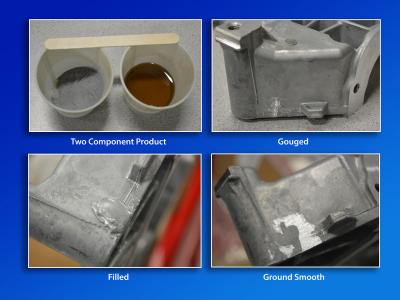
Stronghold Coatings introduces PlasticMetal, a two-component repair technology that can be mixed in various ratios for small and medium repairs to many types of metal. Unlike pre-mixed polymers, which have a set viscosity, this resin and powdered metal system can be mixed in small quantities in thicknesses to suit particular application requirements.
Whether used as a putty, paste or liquid, it yields high compression and tensile strength, and bonds to all metals. This fast-curing compound can be machined after hardening, making it ideal for the repair of defects, pin holes, blow holes and porosity in castings, and to repair machining errors and wear areas in cast iron, steel, aluminum and other alloys. It is highly resistant to physical and thermal stresses, including high chemical resistance, and temperature resistant to 250 degrees C (482 degrees F) continuous. With 12 formulations, including those for cast iron, steel, aluminum, bronze, brass, copper, red brass, iron oxide alloy and ceramic, there are thousands of potential applications across a wide range of industries.
When mixed with various hardeners, PlasticMetal can achieve specific characteristics such as viscosity, cure speed, appearance and performance. It can be applied in place with no special tools.
Contact Details
Related Glossary Terms
- alloys
alloys
Substances having metallic properties and being composed of two or more chemical elements of which at least one is a metal.
- hardening
hardening
Process of increasing the surface hardness of a part. It is accomplished by heating a piece of steel to a temperature within or above its critical range and then cooling (or quenching) it rapidly. In any heat-treatment operation, the rate of heating is important. Heat flows from the exterior to the interior of steel at a definite rate. If the steel is heated too quickly, the outside becomes hotter than the inside and the desired uniform structure cannot be obtained. If a piece is irregular in shape, a slow heating rate is essential to prevent warping and cracking. The heavier the section, the longer the heating time must be to achieve uniform results. Even after the correct temperature has been reached, the piece should be held at the temperature for a sufficient period of time to permit its thickest section to attain a uniform temperature. See workhardening.
- tensile strength
tensile strength
In tensile testing, the ratio of maximum load to original cross-sectional area. Also called ultimate strength. Compare with yield strength.
